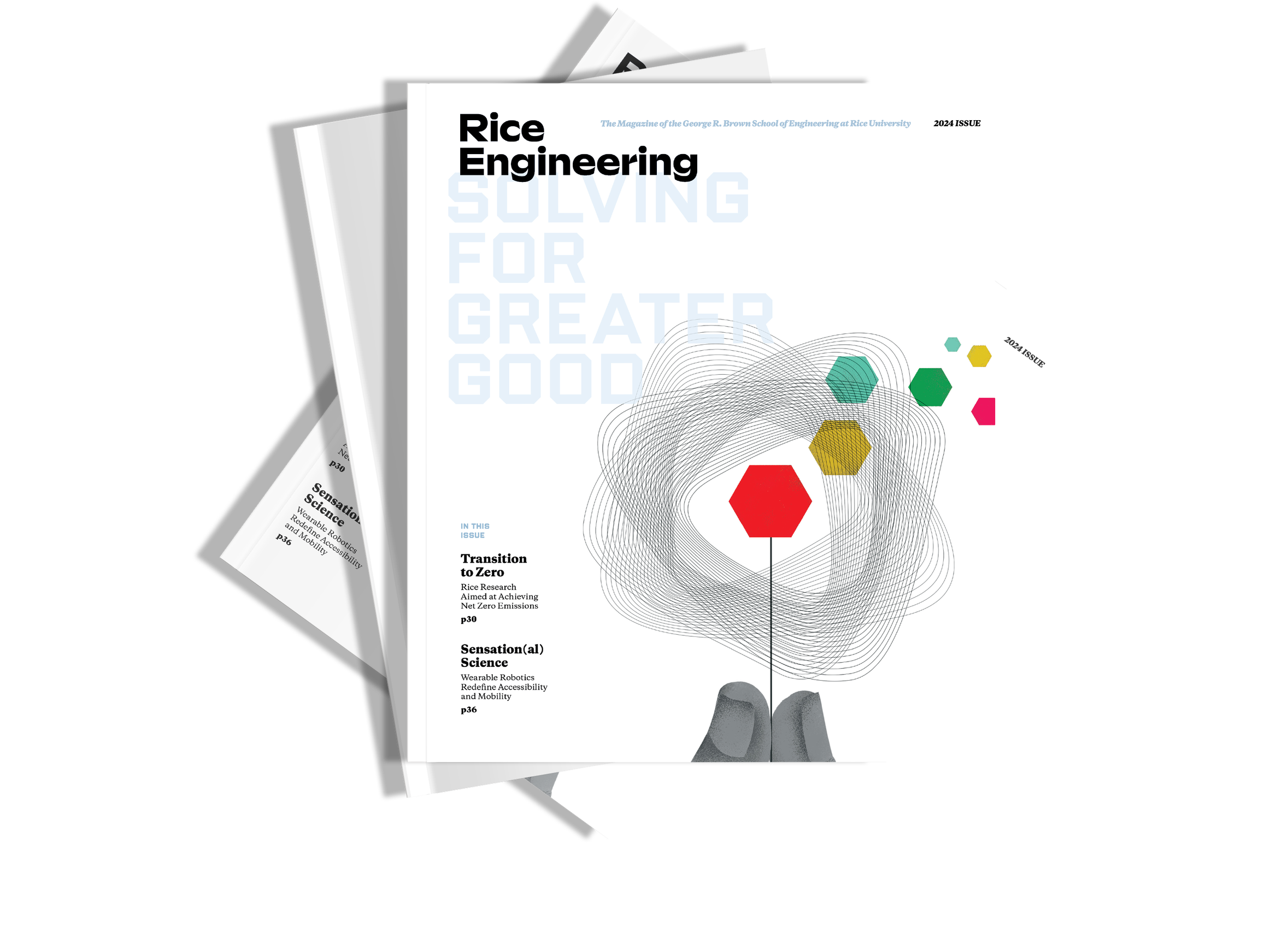
The spring 2024 issue of Rice Engineering Magazine is here!
At Rice Engineering, we are driven by a passion for innovation and a commitment to responsible engineering practices. It’s with great excitement that we unveil the new design of Rice Engineering magazine, which underscores our dedication to excellence in research, education, and service. The 2023-24 issue is full of news about how Rice Engineering is solving for greater good.
Paint Positive
By Veronica E. Tremblay

As the CEO and co-founder of The People’s CO2, a startup offering carbon-capturing paint, Tanya Rogers ’22 has found a way to bring non-scientists into the fight against climate change.
“Look behind you in the air right now. There’s a molecule of CO2. What can you do about it?” Rogers asked. Carbon dioxide is the most prevalent greenhouse gas in Earth’s atmosphere, and methods of capturing and then storing it are important tools in our arsenal in the fight against climate change. But most of these carbon capture tools are large-scale technologies exclusive to industry — where carbon dioxide is extracted from post-combustion emissions in smokestacks or at chemical plants. Rogers said, “If you and I want to do something about climate change, we can take actions like cycle more or ride our bikes. Those kinds of lifestyle choices prevent us from adding to the problem of climate change, but they don’t remove carbon dioxide from the atmosphere right now.”
Rogers, who graduated from Rice with a Ph.D. in chemical and biomolecular engineering and became an energy systems test director at NASA, knew she wanted to create a product that regular people could use themselves to fight climate change directly and immediately.
“What is something everybody has access to?” was her guiding question. She first developed a coating for car air filters, experimenting with recipes for a liquid coating that could capture carbon directly from the air. The car industry presented too many barriers to entry, but the seed for her future brain child was planted. Rogers continued her experiments until she struck upon her final product — paint. People will paint no matter what, so it is better to use one that captures carbon. She brought in fellow Rice graduate Rawand Rasheed ’23 and writer and entrepreneur Slade Ham as co-founders. Her startup company, The People’s CO2, was born.
The company set three goals for its paint. It had to be functional, nontoxic for use in a home and carbon negative to produce.
The People’s CO2 uses olivine in its paint. Olivine, a green silicate used in industry and jewelry, can bind to carbon in the air through a geological process called carbon mineralization, thus sequestering the carbon. A pound of crushed olivine can bind a pound of carbon under ideal conditions, but it takes one to two years to saturate the olivine’s carbon-binding capacity. Paint, which stays in place for a while, is a good medium for the olivine to do this slow work. According to Rogers, The People’s CO2 paint can sequester about half as much carbon as pure olivine — 40% to 50% of its mass in carbon.
“Our concept sounded good, but we needed to test it out,” said Rasheed, co-founder and now CEO of his own startup. To verify the paint was effective, Rogers and Rasheed in one proof of concept measured the mass of various materials, including wood and sheets of metal and paper, painted them with the olivine paint, and measured the mass again. Then, in a controlled environment, they looked at how the mass changed over time to calculate the carbon sequestered within the paint. Rasheed said, “You can actually see the change in mineral composition under a microscope.”
While mining, crushing, and transporting olivine requires energy and therefore emits carbon dioxide, olivine paint needs very tiny particles, such as the waste shavings from processing olivine for industry applications. The People’s CO2 uses industry byproducts, so its cradle-to-grave paint manufacturing is carbon negative. It removes more carbon dioxide from the atmosphere than it emits.
The People’s CO2 plans to expand beyond paint. Right now, the team’s focus is getting “the people” talking about climate action. Over the past year, the company partnered with Space Center Houston and the city of Kemah, Texas, to apply its paint in public spaces. Ham said, “We’re very intrigued by the possibility of a consumer-facing CO2 conversation. Who knows how many people will branch out and initiate their own climate action because of it?” Rogers agreed, “We really want to invite people to join the conversation.”
